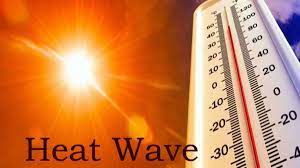
HEAT WAVES
HEAT WAVES I RACE IAS : Best IAS Coaching institute in Lucknow I Current Affairs
HEAT WAVES
Mains Exam General Studies 1
(Important geophysical phenomena related to heat wave, cyclone, earthquake, tsunami, volcano etc.)
Context:
- Recently, the India Meteorological Department (IMD) warned that the maximum temperature over northwest, west and central India would be 3-5°C above the long term average.
- On February 21, 2023, the national capital recorded its third hottest February day (33.6°C) in more than five decades.
What are Heat Waves:
- According to IMD, in the event of a heat wave, the temperature of an area rises by at least 4.5-6.4 degree centigrade above its average temperature.
- When the temperature of plain areas crosses 45 degree Celsius, coastal and hilly areas exceed 37 degree Celsius, then this condition is called heat wave.
Main reasons for the occurrence of Heat Wave in India:
- In the last few years, the heat wave has probably had the greatest impact on the Indian subcontinent. In the year 2022, the effect of heat waves were visible very quickly.
- In the year 2022, due to the north-south depression generated by La Nino, the spread of heat waves were also seen in South India.
- La Nino is a weather phenomenon affecting the world in which a group of cold air flows in an east-west direction over the central Pacific Ocean.
- In the last three years, the effect of El Nino has been felt in North India due to these La Nino.
- El Nino is a weather phenomenon in which warm air flows in the west-east direction over the central Pacific Ocean.
- El Niño plays a major role in the generation of heat waves in North India.
- Increased impact of pucca and concrete roads in urban areas.
- Lack of forest cover and tree cover.
- The urban heat island effect can make the atmosphere feel 3 to 4 degrees higher than normal.
- More heat waves were expected as global temperatures had risen by an average of 0.8 degrees Celsius over the past 100 years. The night temperature is also increasing.
- Climate change is causing higher daily temperatures and longer, more intense heat waves to accelerate globally.
- High intensity of ultra violet rays in medium-high heat wave regions.
- The combination of extraordinary heat stress and a predominantly rural population makes India vulnerable to heat waves.
Impacts of Heat Waves in India
- Frequent occurrences of heat waves adversely affect various sectors of the economy.
- Livelihoods of poor and marginal farmers are negatively affected.
- Crop yield gets reduced. Last year, wheat production decreased by 6-7% due to heat waves in Haryana, Punjab and Uttar Pradesh. Animal wealth and milk productivity are reduced.
- The demand for electricity increases.
- Diabetes, circulation and respiratory diseases also increase due to the effect of excessive heat waves.
- Food insecurity increases in the country.
- There is an unexpected decrease in food production due to the decrease in labor productivity due to heat.
- The impact of heat waves will lead to increase in food prices especially in tropical regions.
- Household income will decrease in coming years and malnutrition and climate-related deaths will increase.
- In the year 2030, the working class working in sectors like agriculture and construction will be severely affected by the heat waves as a large population of India depends on these sectors for their livelihood.
Measures to deal with Heat Waves:
- Identifying heat hot-spots through proper tracking of meteorological data and promoting timely development and implementation of local heat action plans with strategic inter-agency coordination.
- Reviewing existing occupational health standards, labor laws and sectoral regulations to protect workers in relation to climatic conditions.
- There is a need for policy intervention and coordination in all the three sectors of health, water and electricity.
- Promotion of traditional adaptation practices, such as staying indoors and wearing comfortable clothing.
- Encouraging the use of simple design features such as shaded windows, underground water storage tanks and insulating housing materials.
- Advance implementation of local heat action plans, as well as effective inter-agency coordination, is an important response that governments can deploy to protect vulnerable groups.
- We must further improve forecast warnings, issue them more quickly, and link them to city-wide graded heat action plans to protect vulnerable people
- The National Action Plan on Climate Change should be implemented sincerely for inclusive growth and ecological sustainability.
- People should be made aware through print, electronic and social media.
- Private sectors should be encouraged by the government to create 'heat-proof' facilities during heat wave propagation.
---------------------------------------------------------------
|
Mains Exam. Question: What are Heat Waves? Explain the reasons for the occurrence of Heat Waves in India. |